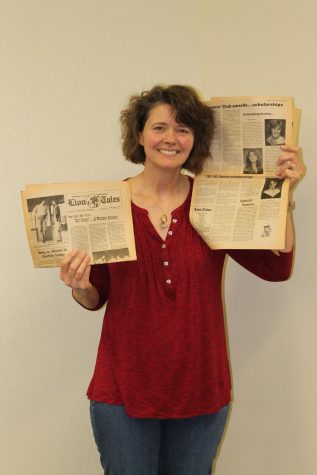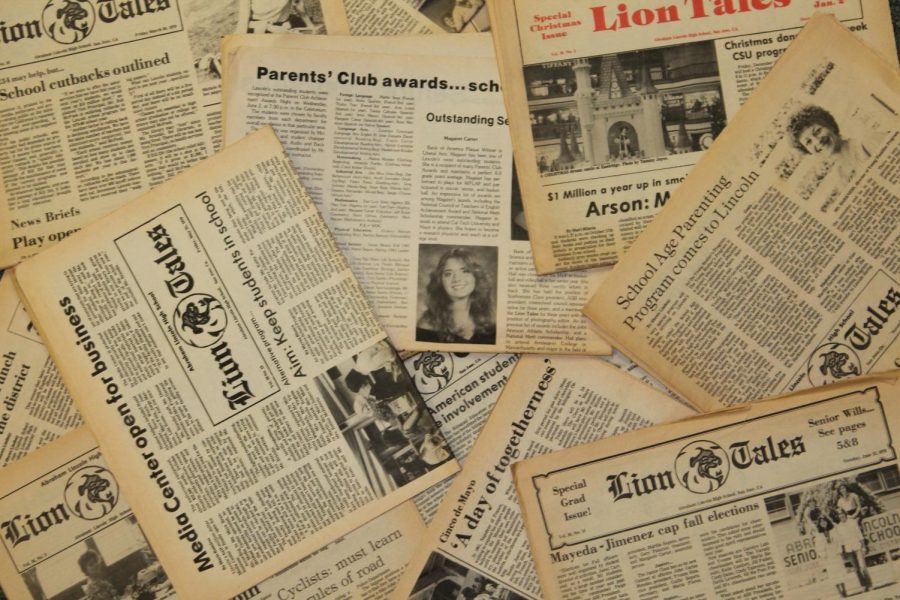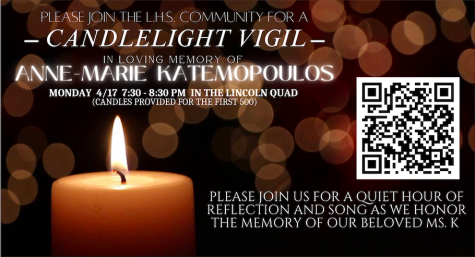Ever Wondered What Lincoln Was Like In The 1980s?
Lincoln Alumni From 1982, Margaret Carter Ma, Explains the High School Experience in the 1980s
Lincoln Lion Tales had the opportunity to speak with an alumni from 1982. Lincoln Lion Tales interviewed Margaret Carter Ma. She provided information about her experience as a high school student at Lincoln. She reached out to Lincoln Lion Tales and chose to donate some archival newspapers from the 1980’s.
Margaret found these archives in her basement and did not remember keeping them. She stated,“maybe something told me they’d be important later.” She had these archives for about 40 years and thinks that they are a snapshot in time.
Margaret decided to donate these archives because she found online archives in the Lincoln Lion Tales website. She scanned the issues she wanted to create digital copies for herself and decided to donate the rest. The purpose was to share the articles with anyone who wanted them. She believed the Lion Tales group was a better caretaker in this respect.
When she looks back she thinks that Lincoln High School, in particular, is a much better place now. Back then, when she attended Lincoln, it was, academically, fairly low achieving as well as very supportive friendship wise. The school was very small and there was no peer pressure. Lincoln was a freeing place to be and, according to Margaret, was what one made it.

In the 1980’s Lincoln looked physically different than what it looks like today. The Black Box Theater was a cafeteria. The Media Center was finished in 1980, and it was filled with books wall to wall. Portables weren’t present. The football field as well as the tennis courts and the gym remains the same.
Everything else was a huge grass field. Behind the parking lot, it was a big orchard. Students would plant crops and it was a class. The students were called “aggies.” At some point the district sold the land.
At Lincoln some sports were wrestling, basketball, football, and basketball. There was a marching band, cheer team and a small drama club. They also had vocational school which was off campus. There was an auto shop, ceramics class, photography, and painting class. However, when the magnet school designation was brought to Lincoln, singing, dancing, acting, and jazz was added.
During Margaret’s time at Lincoln, some events occurred. In 1978, Prop 13 struck Lincoln and it had to do with property tax, which was the way public schools were funded at that time. With Prop 13, schools were funded on a per pupil basis which, because of the low student population, caused Lincoln to receive less money than it had in the past. Since this happened, periods were cut back to 5 and they had 6 before and 7 were optional. Therefore, students couldn’t take college prep classes and couldn’t meet the requirements.
After Prop 13, there was a big teacher strike which lasted for about a month. The strike occurred because more students were put into classes, increasing class size. More students meant more work for teachers. The teachers wanted more money and they received it. In an old article, published on October 17, 1980, Jim Noggle interviewed Mr. Hammer and he stated, “The reason the teachers’ salaries were arrived at last was because there were several other ‘knowns’ that should have been considered first. Utilities, maintenance, deteriorating supplies, such as lab equipment, and other costs had to be paid, many because of neglect in previous years. The district had to catch up.”
Then, a desegregation order came in during her Junior year. The court order went through in October of 1979. The district was told by the court that they cannot have more than some percentage of Hispanic students at each school in the district. The Desegregation is what started the magnet school designation at Lincoln. It wasn’t about race, it was about low standards, according to Margaret. It was to change the focus from busing to Hispanic students having equity access. It was for students to have college prep curriculum.
Mr. Christian also provided some information regarding busing. He stated that there were large numbers of students of color centered in Downtown schools and large number of white students in more South end schools. These kids in the schools really didn’t interact. Because of this matter, the district wanted certain percentages of students’ races at one school.
The district wanted voluntary busing. The focus was to attract students into wanting to attend a school where they would have better opportunities. Therefore, these students would volunteer to bus. In an article from November 26 1980, Trinna Schubert states, “The main aim of the program emphasizing art, music, drama, and dance, is to put a district-wide desegregation process in affect by voluntarily busing from 80 to 100 Anglo students from the South area to Lincoln.”
The magnet school was to attract students from other schools in the San Jose Unified School District to desegregate. As Margaret said, there is no delicate way to say this, they were trying to “bus” in white kids from Leland and Pioneer. It was a matter of demographics.
The District found out the main focus was about holding kids to higher academic standards. The magnet school was a start but what did it was raising the graduation requirements and providing resources which occurred thanks to Dr. Linda Murray. Linda raised the graduation requirements which gave the students the opportunity to attend college (which you can read about here).
The old Lincoln high school requirements to graduate high school were 1 year of math, 1 year of any science for example life science, 4 years PE, 4 years English, 4 years social studies. They did not have to take any type of foreign language and Lincoln had no AP classes to offer. With this requirements students weren’t capable to attend a UC or a CSU. Now a days to graduate Lincoln high school students need to pass their A-G requirements to even walk the stage and get their diploma.
Overall, Margaret’s experience at Lincoln was very positive, and when she attended Lincoln she was interviewed by Lincoln Lion Tales in one articles as a Freshman and said something really “stupid” to the effect of “I think Lincoln is a great school.”
She is seventeen and a senior this year she has also gone to Abraham Lincoln High school for the past four years. She has lived in San Jose for sixteen...
Ariel is a senior, in her 2nd year at Lincoln High School. She transferred from Gunderson to Lincoln her junior year. She is easy to get along with and...












Margaret Ma • Dec 6, 2018 at 6:36 am
Thank you authors Nancy, Sharilyn and Ariel. You did a great job capturing the story.
-Margaret